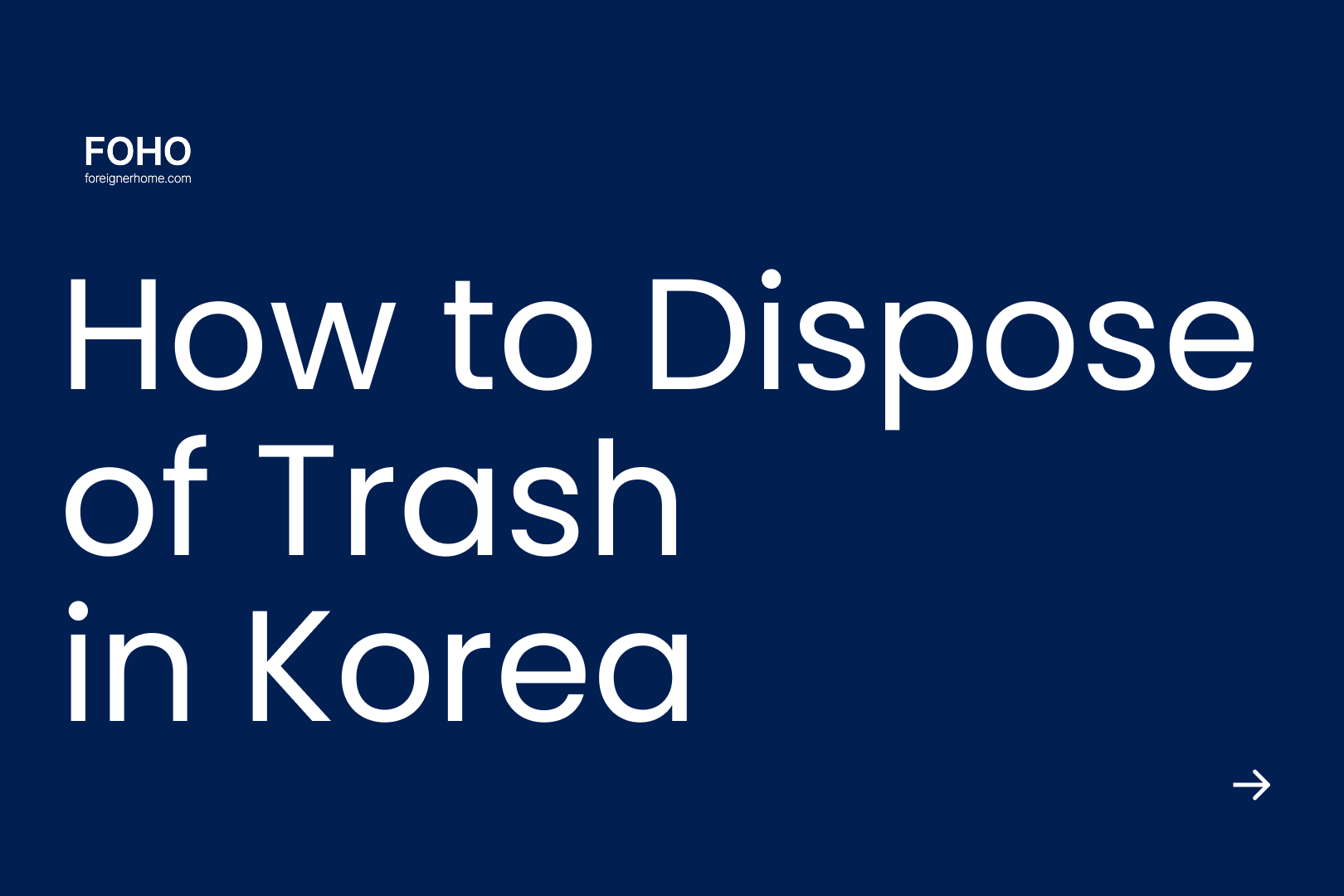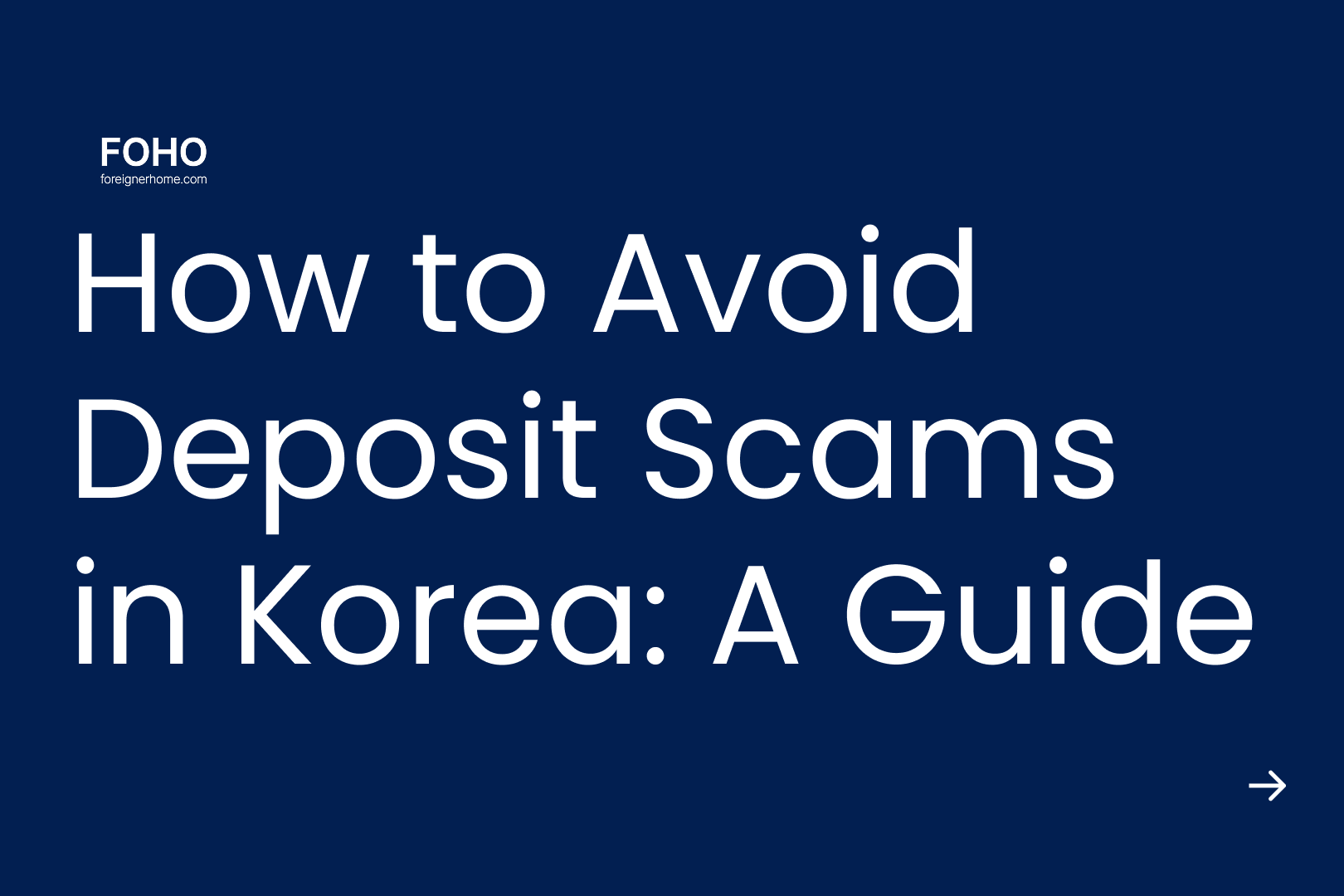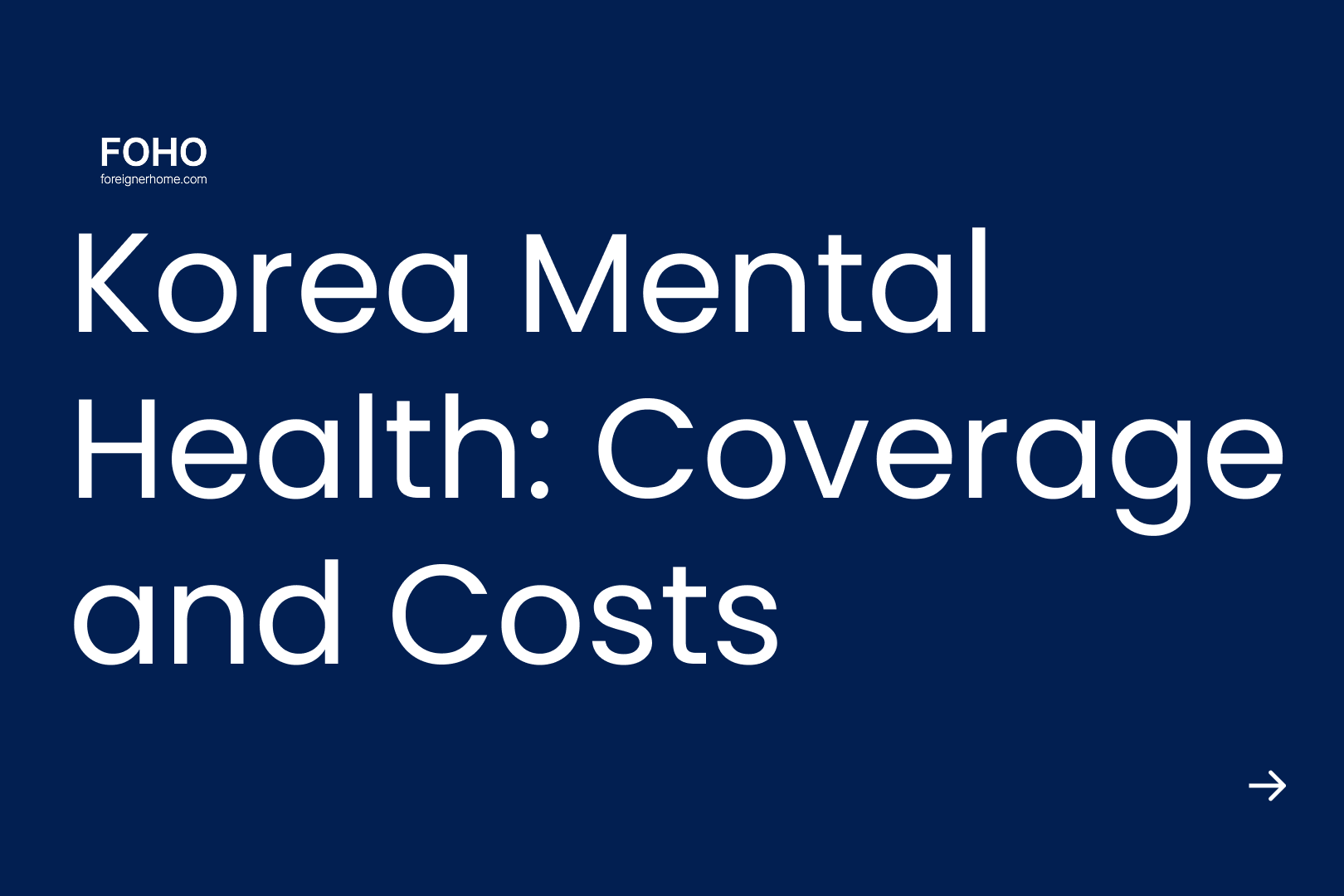FOHO Blog – Global Housing & Living Guide for Foreigners
How to Dispose of Trash in Korea (2025)
Confused by recycling in Korea? This step-by-step guide explains jongnyangje bags, food waste rules, and local sorting for new foreign residents.

Table of contents
- 01The Definitive Guide to Waste Disposal in South Korea: A Practical Handbook for Foreign Residents
- •Section 1: Understanding the System: The "Why" Behind the Rules
- •Section 2: The Three Pillars of Daily Waste
- •Section 3: A Masterclass in Recycling: Item-by-Item Guide
- •Section 4: Handling Special & Hazardous Waste
- •Section 5: Disposing of Large Items: Furniture & Appliances
- •Section 6: Your Local Rulebook: Finding Hyper-Local Information
- •Section 7: A Practical Toolkit for Success
- •Conclusion
- •Find Your Home in Korea, Without the Hassle
- •Footnotes
The Definitive Guide to Waste Disposal in South Korea: A Practical Handbook for Foreign Residents
Section 1: Understanding the System: The "Why" Behind the Rules
1.1. The Jongnyangje (종량제) System: Pay-As-You-Throw
1.2. The Single Most Important Rule: All Waste is Local
Section 2: The Three Pillars of Daily Waste
2.1. General Waste (Ilban Sseuregi, 일반 쓰레기)
- What it includes: Used tissues, sanitary products, diapers, soiled paper, broken ceramics, animal bones, clam shells, eggshells, composite material items (like toothbrushes and pens), and any plastic or vinyl that is too dirty to be cleaned.
- How to dispose: You must use the official Jongnyangje bags designated for your district. These can be purchased at any local convenience store or supermarket. Using a bag from another district is a violation and your trash will not be collected.
2.2. Food Waste (Eumsikmul Sseuregi, 음식물 쓰레기)
- How to dispose: Methods vary significantly by building and district.
- Special Food Waste Bags: Often yellow, these are sold at convenience stores like general waste bags.
- Communal Bins: Common in villas and smaller apartment buildings. You either purchase a payment sticker (napbu piljeung, 납부필증) to attach to the bin or use a pre-paid T-money card on an electronic bin.
- RFID Weighing Systems: Modern apartments often have large, automated bins. Residents scan their personal RFID card, dispose of their food waste, and are charged by weight on their monthly utility bill.
Category | Dispose as Food Waste (Animal Feed) | Dispose as General Waste (Not Animal Feed) |
Vegetables | Soft peels (apple, potato), leftover cooked vegetables | Fibrous peels (onion, garlic, corn husks), hard roots (green onion), chili seeds & stems |
Fruits | Soft seeds (melon, grape) | Hard shells (nuts, pineapple, coconut), large pits (peach, avocado, persimmon) |
Meats & Seafood | Boneless meat, fish meat | All bones (beef, pork, chicken, fish), all shells (clams, crabs, shrimp), toxic parts (pufferfish innards) |
Other | Leftover rice, bread, noodles | Eggshells, tea bags, coffee grounds, herbal medicine grounds |
2.3. Recyclables (Jaehwalyongpum, 재활용품)
- Empty: Remove all contents.
- Rinse: Clean away any food residue.
- Separate: Remove labels, caps, and parts made of different materials.
- Don't Mix: Keep different material types separate.
Section 3: A Masterclass in Recycling: Item-by-Item Guide
3.1. Paper & Cardboard (Jongi-ryu, 종이류)
- Recyclable: Newspapers, books, notebooks, cardboard boxes.
- Preparation: Remove all plastic tape, metal staples, and plastic-coated covers. Flatten boxes and tie everything together with string. Keep it dry.
- Not Recyclable (General Waste): Thermal receipts, photos, oily paper (e.g., paper lining a pizza box), wallpaper, shredded paper, diapers.
3.2. Paper Cartons (Jongi-paek, 종이팩)
- Recyclable: Milk cartons, juice boxes, soymilk packs.
- Why it's separate: These cartons have a plastic or foil lining, requiring a different recycling process than regular paper.
- Preparation: Empty, rinse thoroughly, flatten, and dry. Remove any plastic caps or straws. Bundle them separately from other paper products.
3.3. Glass Bottles (Yuri-byeong-ryu, 유리병류)
- Recyclable: Beverage bottles, food jars.
- Preparation: Empty, rinse, and remove plastic or metal caps (recycle those separately). Removing the paper label is recommended.
- Bottle Deposit Refund: Soju and beer bottles have a small deposit (₩100-₩130) included in the price. You can return these to supermarkets for a cash refund.
- Not Recyclable: Broken glass (wrap carefully in newspaper and place in a general waste bag), crystal, heat-resistant glass (Pyrex), light bulbs, mirrors, ceramics.
3.4. Metal Cans & Scrap (Kaen-ryu/Gocheol-ryu, 캔류/고철류)
- Recyclable: Aluminum/steel beverage cans, food cans, scrap metal.
- Preparation: Empty, rinse, and crush if possible. Remove any plastic lids.
- Safety Warning: Aerosol cans or butane canisters must be completely empty. Pierce a hole in them outdoors in a well-ventilated area before disposal to prevent explosions.
3.5. Plastics (Peullaseutik-ryu, 플라스틱류)
- The Golden Rule for Plastics: A new, mandatory rule requires transparent, colorless PET bottles (from water or soft drinks) to be disposed of separately from all other plastics.
- Transparent PET Bottles: Empty, rinse, remove the label completely, crush the bottle flat, and replace the cap. Dispose of in the designated "투명페트" bin or bag.
- Other Plastic Containers: This includes colored PET bottles, shampoo/detergent containers, and yogurt cups. Prepare them by emptying, rinsing, and removing any non-plastic parts (like metal pump springs).
- Not Recyclable (General Waste): Toys, pens, toothbrushes, CDs, plastic hangers, and any items made of multiple mixed materials.
3.6. Vinyl & Film Packaging (Binil-ryu, 비닐류)
- Recyclable: Snack bags, instant noodle wrappers, plastic bags, bubble wrap.
- Preparation: Only clean vinyl is recyclable. It must be free of food residue or dirt. If it cannot be cleaned easily, it must be thrown in general waste. Collect all clean vinyl in a single transparent bag.
- Not Recyclable (General Waste): Cling wrap, rubber gloves, tablecloths, heavily soiled vinyl.
3.7. Styrofoam (Seutiropom, 스티로폼)
- Recyclable: Clean, white styrofoam packaging.
- Preparation: Remove all tape, shipping labels, and stickers. If it held fresh produce or fish, it must be rinsed clean. Break large pieces down.
- Not Recyclable (General Waste): Colored styrofoam, cup noodle containers (often stained and contaminated), fruit netting.
Item | Correct Disposal Method | Reason & Notes |
Cup Noodle Container | General Waste | Almost always stained by oily broth, making it unrecyclable. |
Aluminum Foil | General Waste | Too thin and often contaminated with food, making recycling inefficient. |
Eggshells | General Waste | Unsuitable for animal feed and do not compost well. |
Toothbrush | General Waste | Composed of mixed materials (plastic, nylon, rubber). |
Receipts | General Waste | They are thermal paper, not regular paper. |
Ice Pack (Gel Type) | General Waste (do not cut open) | The gel is a non-recyclable superabsorbent polymer. If the pack contains only water, pour the water out and recycle the vinyl casing. |
Section 4: Handling Special & Hazardous Waste
- Clothing & Textiles: Use the large green or white collection bins found in residential areas, labeled 의류 수거함 (Uiryu Sugeoham). Acceptable items include wearable clothes, paired shoes, bags, and curtains. Do not deposit pillows, thick blankets, carpets, or wheeled luggage.
- Batteries & Fluorescent Bulbs: These contain hazardous materials. Dispose of them in the designated collection boxes found at your local community center (jumin center, 주민센터) or in dedicated bins within apartment complexes.
- Expired Medicine: Do not throw medicine in the trash or flush it down the toilet, as it contaminates soil and water. Return all expired or unused medication to the collection boxes at any local pharmacy or public health center.
- Cooking Oil: Pouring oil down the sink causes severe pipe blockages. Your building may have a dedicated oil collection bin. If not, small amounts can be absorbed with paper towels and thrown in general waste. You can also inquire at your community center about disposal methods.
Section 5: Disposing of Large Items: Furniture & Appliances
5.1. Bulky Waste (Daehyeong Pyegimul, 대형 폐기물) Sticker System
- Identify Item & Fee: Determine the exact type and size of the item you are discarding. The fee will vary accordingly.
- Declare & Pay:
- Online (Recommended): Visit your local Gu Office website and find the "Large Waste" (대형 폐기물) section. Select your item from the list, pay the fee online, and print the declaration certificate. If you don't have a printer, you can write the confirmation number on a piece of paper.
- Offline: Go to your community center (jumin center) or a designated local mart and purchase a physical sticker for your specific item.
- Attach & Dispose: Attach the printed certificate or physical sticker securely to the item. Place the item outside in the designated collection area on the specified day or evening.
5.2. Large Home Appliances: Free Collection Service
- Eligible Items: Large appliances (over 1m in height) are collected for free. You can often include smaller appliances (microwaves, fans) with a large item pickup.
- How to Book:
- Website: www.15990903.or.kr
- Phone: 1599-0903
- KakaoTalk ID: 폐가전무상방문수거 A collection team will schedule a visit, enter your home, and remove the item for you.
Section 6: Your Local Rulebook: Finding Hyper-Local Information
6.1. Your District (Gu) Office Website is Your Best Friend
Category | Seocho-gu, Seoul | Haeundae-gu, Busan |
General Waste Days | Varies by dong (e.g., Sun, Tue, Thu) | Sun, Tue, Thu |
Recycling Days | Same day as general waste | Item-specific days:
- Mon: Plastics, Cans, Glass
- Wed: Paper, Vinyl, Styrofoam |
Disposal Time | 18:00 - 01:00 | 18:00 - 21:00 |
Food Waste Days | Daily (except Saturday) | Sun, Tue, Thu |
Special Notes | No waste disposal on the day before a public holiday. | Non-combustible waste is collected on Mondays and Wednesdays. |
Section 7: A Practical Toolkit for Success
7.1. Digital Assistant: Nae Sonan-ui Bunlibaechul App
7.2. Understanding Penalties: A Summary of Fines
Violation | Fine Amount (KRW) |
Littering small trash (cigarette butts, tissues) | ₩50,000 |
Disposing of household waste in a plastic shopping bag (not an official bag) | ₩200,000 |
Mixing recyclables or food waste in a general waste bag | ₩100,000 - ₩300,000 |
Disposing of large waste without a sticker/declaration | ₩100,000+ |
Unauthorized incineration or burial of waste | Up to ₩1,000,000 |
7.3. Pro-Tips from the Community
- "When in doubt, throw it out." If you are unsure whether an item is recyclable, it is better to put it in the general waste (jongnyangje) bag than to contaminate the recycling stream.
- Freeze food waste. Especially in hot summers, storing your food waste bag in the freezer until collection day is a very effective way to prevent odors and pests.
- Ask for help. Don't hesitate to ask your building manager (gwanli-in, 관리인), a Korean neighbor, or even a convenience store clerk for guidance. The Seoul Dasan Call Center (dial 120) also offers foreign language support.
- Observe your neighbors. The best way to learn the specific system for your building is to see how others are doing it.
Conclusion
Find Your Home in Korea, Without the Hassle
Footnotes
Settle in faster with FOHO
Browse more verified listings and message landlords in minutes. Lock in your lease with FOHO's secure payments.
Get Foreigner-Friendly Housing Tips
Get the latest news delivered to your inbox.

Nov 4, 2025
FOHO Launches Foreigner-Focused Rental Insurance
FOHO’s deposit insurance protects foreign tenants in Korea from landlord defaults. Stay safe with clear coverage and fast claims.

Oct 31, 2025
How to Convert E-9 Visa to E-7-4 in Korea
A guide for Vietnamese & Chinese E-9 workers in Korea. Learn the E-7-4 visa points system, F-2 requirements, and compare GME vs. Sentbe for remittance.

Oct 30, 2025
How to Avoid Deposit Scams in Korea: A Guide
Avoid deposit scams in Korea with our step-by-step guide. Learn to check property debt, understand the 'Deung-gibu,' and secure your deposit.

Oct 29, 2025
Korea Mental Health: NHIS Coverage and Costs
Get help with mental health in Korea. This guide for foreigners explains how to use NHIS, find low-cost options, and get medication prescriptions locally.
Subscribe to the FOHO newsletter
Actionable housing insights in your inbox.